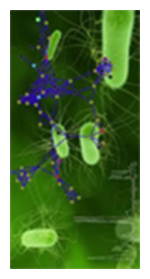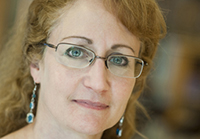Microbiomes and Microbiomics
Jo Handelsman
Principal Assistant Director for Science
White House Office of Science and Technology Policy
HHMI Investigator and Rose Prof. of Molecular, Cell & Dev. Biology
Yale University
About the Lecture

The microbiome is the community of microorganisms that inhabits an environment, such as the human body, animals, soil, oceans, and every other ecosystem on Earth. The last decade has witnessed an explosion of knowledge about microbiomes in many habitats that has been accompanied by the realization that microorganisms control the health of virtually every ecosystem on Earth. The effects of microbiomes are far reaching. In human health, the microbiome is associated with chronic diseases such as obesity, diabetes, depression, and asthma, conditions that were long assumed to be due to other causes. In the environment, crop productivity, climate change, and ocean health are all influenced by microbiomes. There is tremendous potential for managing microbiomes to achieve beneficial outcomes for human health, agricultural productivity, clean energy supply, environmental health, and in the economy, but a new approach to microbiome research is needed to realize them. This lecture will discuss the new science of microbiomics, what we have learned about microbiomes, and how we may be able to use this knowledge to improve health, enhance agricultural techniques, and better preserve our environment.
About the Speaker

Jo Handelsman is the Associate Director for Science at the White House Office of Science and Technology Policy and is on leave from her positions as the Howard Hughes Medical Institute Professor and Frederick Phineas Rose Professor in the Department of Molecular, Cellular and Developmental Biology at Yale University. Before joining the Yale faculty she was Chair of the Department of Bacteriology and Professor in Plant Pathology at the University of Wisconsin-Madison. Jo is an expert in communication among bacteria that associate with soil, plants, and insects. She is a pioneer of the field of metagenomics, particularly in the agricultural and medical sciences. She also has done important and notable research on science education and on women and minorities in science. She co-founded the Wisconsin Program for Scientific Teaching, the Yale Center for Scientific Teaching, and the National Academies Summer Institute on Undergraduate Education. She also co-chaired the PCAST working group that developed the “Engage to Excel” report on meeting the Nation’s STEM needs in the coming decade. Among many awards and honors Jo was elected and served as President of the American Society for Microbiology and received the Presidential Award for Excellence in Science Mentoring. Jo earned a BS at Cornell University and a PhD in Molecular Biology at the University of Wisconsin-Madison.
Minutes
President Larry Millstein called the 2353rd meeting of the Society to order at the Cosmos Club in Washington, D.C. on November 6, 2015 at 8:09 p.m. He announced the order of business and welcomed new members. The minutes of the previous meeting were read and approved. President Millstein then introduced the speaker for the evening, Jo Handelsman, Associate Director for Science in the White House Office of Science and Technology Policy. Her lecture was titled “Microbiomes and Microbiomics”.
Dr. Handelsman began by addressing the “gut” reaction that we have toward microorganisms. For as long as we have known about them, microorganisms have largely been associated with disease and suffering, such as the Yersinia pestis bacterium (the Black Plague), or the Phytophthora infestans fungus responsible for the Irish potato famine.
Despite these catastrophes shaping our cultural understanding of microbes, the beneficial effects of microbes are myriad. They produce vitamins that are necessary for human life, such as Vitamin K. They also protect us from disease by outcompeting harmful pathogens.
Perhaps the best known gift of microorganisms is antibiotics. Alexander Fleming’s discovery of penicillin in 1928, and its subsequent mass production during WWII, resulted in the first war in which more people died as a result of combat injuries than from disease and secondary infection. Since then, infectious diseases have never had the same grip on humanity.
The 20th century was a golden age for infectious disease research and the discovery of many new antibiotics, mostly from bacteria in soil cultures. Unfortunately, research on new antibiotics dropped significantly in the 1980s, as pharmaceutical companies determined them to be cost-ineffective to develop. As of now, we have only four major drug companies that do antibiotic discovery.
At the same time, we have seen an increasing rate of antibiotic resistance. The single most threatening example is Multiple Drug Resistant tuberculosis, which has been identified by the World Health Organization and the United States as a top priority. Once again, after almost a century, we are facing bacterial infections for which there is no cure.
Fortunately, recent developments have provided new avenues for research. Until the late 20th century, most of our knowledge of microbes came from those that were grown in a lab, on a Petri dish. But most microorganisms do not grow under standard culturing conditions. Research to date had concentrated on those unusual bacteria that did grow in the lab.
What changed that paradigm? – the work of Australian researchers Barry Marshall and Robin Warren on Helicobacter pylori. They had discovered a clear correlation between H. pylori and ulcers, but could not convince the scientific community of the causation, in part because H. pylori was not culturable and had not been widely studied. Marshall himself drank a large preparation of the bacterial culture and duly developed gastritis from an H. pylori infection. The medical establishment was caught by surprise that an unculturable organism had such profound effects on human health.
By the late 20th century, metagenomic sampling methods were being used to analyze microbes extracted directly from the environment, bypassing culturing. These methods showed that lab-culturable microbes accounted for less than 1/1,000th of the microbial DNA in the biosphere. Moreover, as much as 80% of the genes identified had no known match and no known function. In her own research, Dr. Handelsman inserted the newly identified genes into culturable organisms. This research identified many new traits, including the roots of antibiotic resistance.
Metagenomics also provides insight into the role and effects of the estimated 100 trillion bacteria that live on and in our bodies. Dr. Handelsman then discussed new findings about intestinal flora that may have treatment implications for obesity and even autism.
She also discussed the treatment of Clostridium difficile. Dr. Handelsman explained that C. diff does not respond to antibiotics in 30% of cases and is often life threatening. Experimental fecal matter transplants from people living in the same house restored the “normal” gut microbiota in patients and produced recovery in as little as 24 hours.
Dr. Handelsman ended her lecture with a story about Biosphere II, the closed ecosystem experiment in Arizona. Despite painstaking calculations to ensure a balanced and self-sustaining ecosystem, within six months the oxygen was depleted and the experiment ended because the metabolism of the soil microbes had not been taken into account. We forgot about the microbes in Biosphere II because we could not see them, Dr. Handelsman said, and we cannot afford to repeat our mistakes in the biosphere in which we all live.
After the question and answer period, President Millstein thanked the speaker, made the usual housekeeping announcements, and invited guests to join the Society. At 9:57 p.m., President Millstein adjourned the 2353rd meeting of the Society to the social hour.
Attendance: 105
The weather: Overcast
The temperature: 21°C
Respectfully submitted,
Preston Thomas
External Communications Director